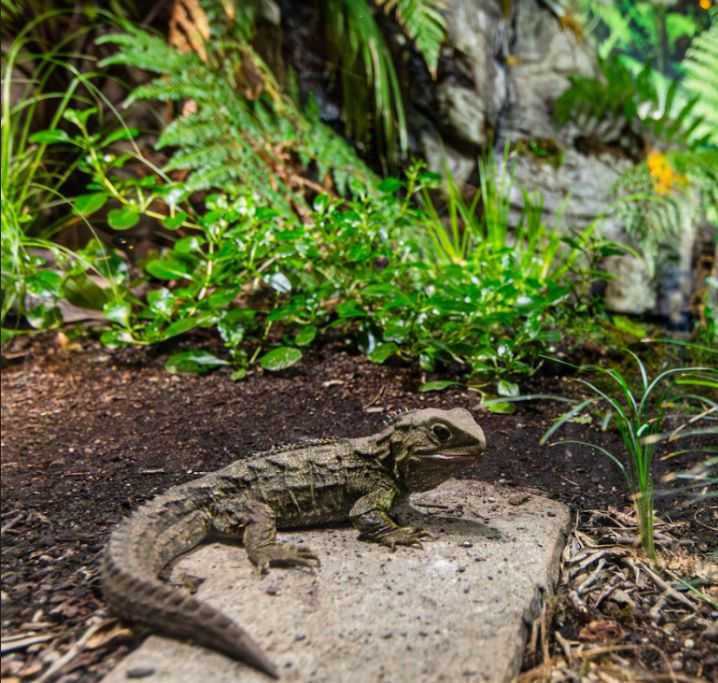Unveiling Ancient Wonders! Tuatara Day: A Reptilian Celebration Of New Zealand's Living Fossils

SEA LIFE Kelly Tarlton’s Aquarium is paying homage to the ancient tuatara, a living relic with roots stretching back over 200 million years. Recognising the guardianship of Ngāti Koata, the aquarium proudly showcases four of these remarkable creatures for educational enrichment, inspiring visitors about the significance of the tuatara.
On Tuatara Day, 2 May, SEA LIFE Kelly Tarlton's is inviting guests to honour these living fossils, essential to the natural heritage of Aotearoa New Zealand.
Once roving the land freely, this existence of tuatara now hangs in the balance, threatened by habitat loss, invasive species, and low reproductive rates. Protected by law, with just 32 islands serving as their sanctuary, the tuatara embodies vulnerability and resilience, underscoring the urgent need for conservation efforts.
With their unique features, including spiny crests, textured skin, and the enigmatic third eye, tuatara captivate all who encounter them. Slow to mature and boasting lifespans exceeding a century, they defy the boundaries of time, offering a glimpse into the mysteries of evolution.
Kim Evans, Displays Manager, SEA LIFE Kelly Tarlton’s, said, “Tuatara Day is more than just a celebration; it's a call to action for conservation of this species. By educating the public of their conservation priority, we aim to instil a profound respect for New Zealand's rich biodiversity and safeguard the future of tuatara populations in the wild.”
Guests can see the tuatara and discover a range of other marine and freshwater creatures at SEA LIFE Kelly Tarlton's, including sharks, rays, turtles, sub-Antarctic penguins, and more! To book tickets head to www.visitsealife.com/auckland
About the Tuatara
- The Tuatara (Sphenodon punctatus) is a reptile species endemic to New Zealand, representing a living relic of the dinosaur era. With a lineage that can be traced back over 200 million years, they are often referred to as "living fossils."
- Tuatara possess unique physiological features, including a third eye located on the top of their heads known as the parietal eye. While not a true eye, it is sensitive to light and helps regulate their circadian rhythms.
- These fascinating creatures exhibit exceptionally slow growth rates and have an exceptionally long lifespan. They reach sexual maturity at around 15-20 years old and can live for over 100 years, with some individuals reaching 200 years or more.
- Tuatara are considered a conservation priority due to their vulnerability stemming from habitat loss, predation by introduced species, and low reproductive rates. They are now confined to 32 islands, where they are protected by law.
- As predators, tuatara play a crucial role in maintaining ecological balance by controlling populations of insects and other small animals. They are also important indicators of ecosystem health, reflecting the overall condition of their habitats.
- Tuatara are endemic to New Zealand and used to inhabit the mainland. However, they are now primarily found on offshore islands due to habitat modification and predation by introduced mammals like rats and cats.
- Tuatara hold cultural significance for Indigenous Māori communities in New Zealand, with some tribes considering them as kaitiaki (guardians). Recognition of this cultural importance is integral to conservation efforts and management strategies for tuatara populations.


 NZSEG: Powering The Future - NZSE College And Royal New Zealand Navy Forge Educational Partnership
NZSEG: Powering The Future - NZSE College And Royal New Zealand Navy Forge Educational Partnership Courtney Duncan: Illness Prevents Duncan From Contesting First Round Of 2025 World Women’s Motocross Championship
Courtney Duncan: Illness Prevents Duncan From Contesting First Round Of 2025 World Women’s Motocross Championship GPNZ: Extended Skill Mix In Primary Care Teams Improves Patient Access And Outcomes
GPNZ: Extended Skill Mix In Primary Care Teams Improves Patient Access And Outcomes New Zealand Symphony Orchestra: Music Legend To Conduct Bach, Beethoven And Mozart With NZSO
New Zealand Symphony Orchestra: Music Legend To Conduct Bach, Beethoven And Mozart With NZSO Ministry of Health: Ministry Of Health To Look Further At Waikato Hospital Event
Ministry of Health: Ministry Of Health To Look Further At Waikato Hospital Event Emirates Team NZ: Statement From Emirates Team NZ On Auckland Hosting Of 38th America’s Cup
Emirates Team NZ: Statement From Emirates Team NZ On Auckland Hosting Of 38th America’s Cup